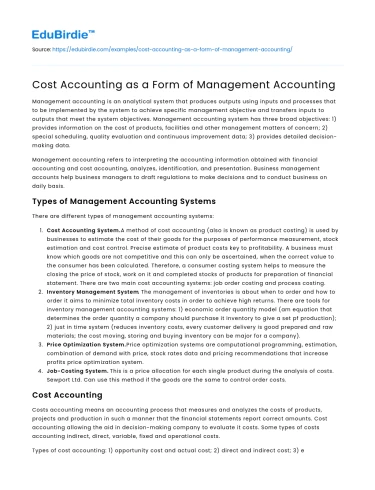Management accounting is an analytical system that produces outputs using inputs and processes that to be implemented by the system to achieve specific management objective and transfers inputs to outputs that meet the system objectives. Management accounting system has three broad objectives: 1) provides information on the cost of products, facilities and other management matters of concern; 2) special scheduling, quality evaluation and continuous improvement data; 3) provides detailed decision-making data.
Management accounting refers to interpreting the accounting information obtained with financial accounting and cost accounting, analyzes, identification, and presentation. Business management accounts help business managers to draft regulations to make decisions and to conduct business on daily basis.
Save your time!
We can take care of your essay
- Proper editing and formatting
- Free revision, title page, and bibliography
- Flexible prices and money-back guarantee
Types of Management Accounting Systems
There are different types of management accounting systems:
- Cost Accounting System. A method of cost accounting (also is known as product costing) is used by businesses to estimate the cost of their goods for the purposes of performance measurement, stock estimation and cost control. Precise estimate of product costs key to profitability. A business must know which goods are not competitive and this can only be ascertained, when the correct value to the consumer has been calculated. Therefore, a consumer costing system helps to measure the closing the price of stock, work on it and completed stocks of products for preparation of financial statement. There are two main cost accounting systems: job order costing and process costing.
- Inventory Management System. The management of inventories is about when to order and how to order it aims to minimize total inventory costs in order to achieve high returns. There are tools for inventory management accounting systems: 1) economic order quantity model (am equation that determines the order quantity a company should purchase it inventory to give a set pf production); 2) just in time system (reduces inventory costs, every customer delivery is good prepared and raw materials; the cost moving, storing and buying inventory can be major for a company).
- Price Optimization System. Price optimization systems are computational programming, estimation, combination of demand with price, stock rates data and pricing recommendations that increase profits price optimization system.
- Job-Costing System. This is a price allocation for each single product during the analysis of costs. Sewport Ltd. Can use this method if the goods are the same to control order costs.
Cost Accounting
Costs accounting means an accounting process that measures and analyzes the costs of products, projects and production in such a manner that the financial statements report correct amounts. Cost accounting allowing the aid in decision-making company to evaluate it costs. Some types of costs accounting indirect, direct, variable, fixed and operational costs.
Types of cost accounting: 1) opportunity cost and actual cost; 2) direct and indirect cost; 3) explicit and implicit cost; 4) historical and replacement cost; 5) fixed cost and variable cost; 6) real and prime cost; 7) total, average and marginal cost.
Traditional method of cost accounting are: general industrial expenses, distribution of cost with percentages, cost-Centre’s, transport of cost in the products according to the volume of production and products.
Activity-base cost accounting includes: general industrial expenses, distribution of cost based on the cost-drivers that connects expenses with activities, activities, transport of cost in the products according to the activities and products. ABC System is more accurate than traditional cost accounting.






 Stuck on your essay?
Stuck on your essay?

